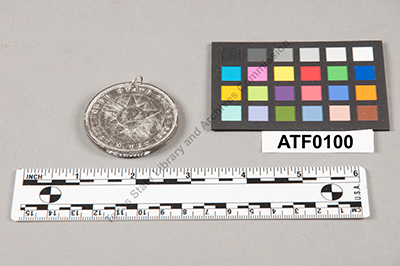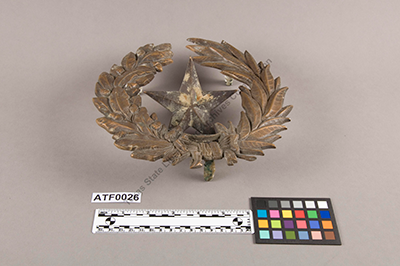Cabinet of Curiosities
In This Exhibit: Official Acts | Riding High | Out on the Range | Men in Style
Dressed to the Nines | Home Sweet Home | Deconstructing the Capitol | HOME
Deconstructing the Capitol
The current Texas State Capitol building in downtown Austin has brought legislators, government workers, and tourists alike to the site since its celebratory opening in 1888. The previous limestone structure, which burned in 1853, was so architecturally unappealing that Texans had already decided to erect a new one, and designs were underway at the time of the fire. TSLAC preserves the architectural drawings of the 1888 Capitol building, along with photographs of the construction project.
Artifacts once a part of the Capitol and related to its construction are included in the State Archives collections. A sundial, doorknob, and a carpenter’s rule are only a few representative items connected to the building. Find more artifacts, images, drawings, and documents online in the Texas Digital Archive at www.tsl.texas.gov/texasdigitalarchive and by visiting our research room.
Exhibit Items
Capitol. 1888. Early 1900's. Austin, Texas, photo of photoengraving. Places Collection, 1/103-49, Prints and Photographs. TSLAC. View larger image of Capitol. 1888. Early 1900's. Austin, Texas, photo of photoengraving on our Texas Digital Archive Site. 
Sundial, 1791, 1876. Artifacts Collection, ATF0316. TSLAC. Square metal base with a circle etched within. The circle forms the clock and has numbers in Roman numerals etched along the circumference. At the head of the clock are the words: Ed x Walton. Below is a stylized image of the sun with eyes, nose, and a mouth. Also etched on the sun is 1719. It bears the dates 1719 and 1876. Inscribed below the Roman numerals: Presented to the State of Texas by W. Walton of Bosque Co., Nov. 19, 1894, through Al Musgrove and deposited in the State Library. Borrowed from the Dept. of Statistics and History by the Superintendent of Public Buildings and Grounds, September 22, 1904.
This sundial was used in 1719. The creator's signature is on one corner: W. Walton, 1876. There are four holes along the corners of the metal base. This sundial is believed to have once been securely fastened to a granite pedestal at the south entrance of the Capitol building.
View larger image of Sundial, 1791, 1876 on our Texas Digital Archive Site. 
Trowel of Herman August Zeplin, 1870-1880. Artifacts Collection, ATF0099. TSLAC. Trowel with wooden handle. Metal blade, shank, heel, and toe. This is a bricklayer's trowel used by Herman August Zeplin, stone mason, during the construction of the Texas State Capitol building. Mr. Zeplin (1859-1936) was a carpenter and contractor in Austin, Texas.
View larger image of Trowel of Herman August Zeplin, 1870-1880 on our Texas Digital Archive Site. 
Elevations of dome, January 10, 1882. Architectural drawings and derivatives, 1994/083-33, Texas Capitol Building Commission. TSLAC. View larger image of Elevations of dome, January 10, 1882; Architectural drawings and derivatives, 1994/083-33 on our Texas Digital Archive Site. 
Brass knob and hinge from Capitol building, 1977. Artifacts Collection, ATF0210. TSLAC. Brass knob, door plate and hinge. Hinge is ornately patterned, has a metal plate on either side, and the words Texas Capitol inscribed. Written on the reverse with a red marker: New Room. Written on the reverse of the door plate: Sargent & Co. 388A. The doorknob is similarly ornate and has the image of the Texas Lone Star in the middle of a laurel wreath on both ends.
This brass doorknob and hinge are from the present Texas State Capitol building. The carved wood door frames at the Capitol are emphasized with elaborate, custom-designed bronze hinges and hardware produced using glass molds made especially for the building by Sargent and Co. of New Haven, Connecticut, in the late 1880s. They weigh over seven pounds each.
Dedication of the Texas State Capitol medal, 1888. Artifacts Collection, ATF0100. TSLAC. Silver medal. Depicts image of the Texas State Capitol. Etched: Dedication of the Texas State Capitol; Official Souvenir; Patented Dec. 6, 1887; Austin, Texas May 16, 1888. Etched on the reverse: Inter State Drill; Gov. L.S. Ross; Austin, Tex. 1888. Image of a star with the profile of a bearded man in the center. Small hole on top.
![Capitol building site, Austin. Views of Austin and surroundings [1883-1888]. Capitol building site, Austin. Views of Austin and surroundings [1883-1888].](/sites/default/files/public/tslac/exhibits/curiosities/1965089_14a_wm.png)
Capitol building site, Austin. Views of Austin and surroundings [1883-1888]. Ernest J. von Rosenberg Collection, 1965/89-14, Prints and Photographs. TSLAC.
Star and wreath, 1850-1880. Artifacts Collection, ATF0026. TSLAC. Metal star and wreath, two pieces. Include mounting prongs for mounting on stone or wall. This Republic of Texas wreath and star (representative of the Texas state seal) were received from the Southwest Texas State College (present day Texas State University) in 1964 and are believed to have been embedded in cement over the entrance of the first Texas State Capitol building.
View larger image of Star and wreath, 1850-1880 on our Texas Digital Archive Site. 
E.E. Myers' carpenter's rule, 1870-1885. Artifacts Collection, ATF0206. TSLAC. Silver and ivory rule bearing the inscription: E.E. Myers, Architect, Detroit, Michigan. This carpenter's rule was given to Mr. G.W. Lacy by E.E. Myers, architect of the Texas State Capitol. In 1885, G.W. Lacy and two other men, W.H. Westfall and N.L. Norton, gave the state of Texas enough granite from Granite Mountain to build the statehouse.
View larger image of E.E. Myers' carpenter's rule, 1870-1885 on our Texas Digital Archive Site. 
Home - Cabinet of Curiosities ->
Cabinet of Curiosities Exhibit Pages:
Home | Official Acts | Riding High | Out on the Range | Men in Style | Dressed to the Nines | Home Sweet Home | Deconstructing the Capitol









